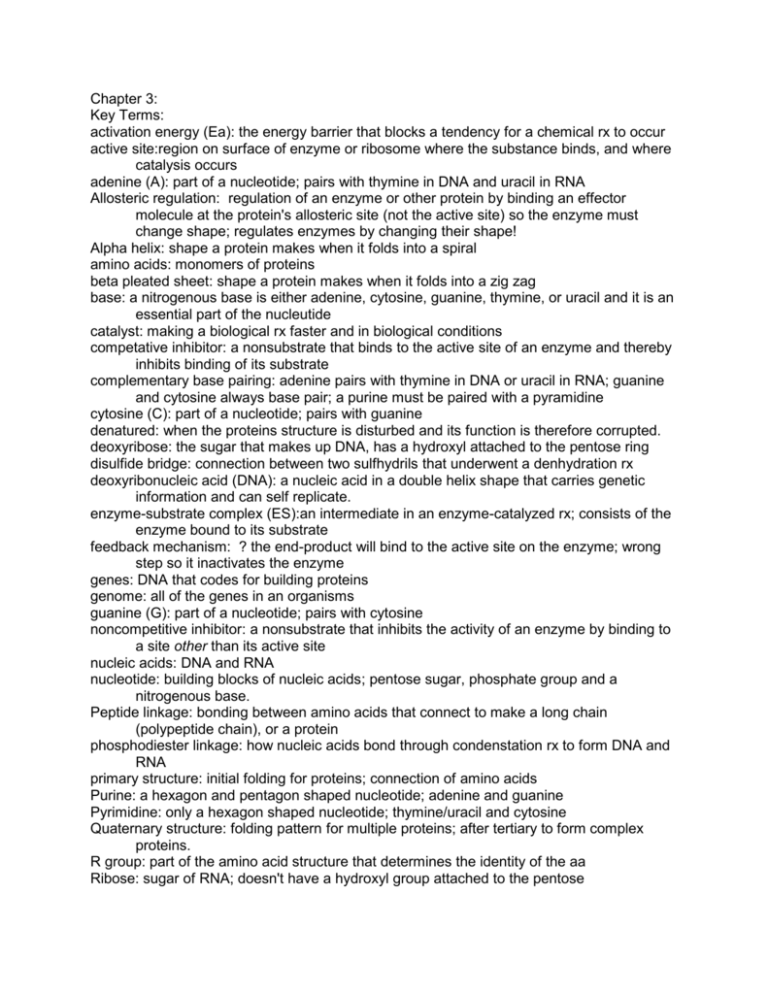File
advertisement

Chapter 3: Key Terms: activation energy (Ea): the energy barrier that blocks a tendency for a chemical rx to occur active site:region on surface of enzyme or ribosome where the substance binds, and where catalysis occurs adenine (A): part of a nucleotide; pairs with thymine in DNA and uracil in RNA Allosteric regulation: regulation of an enzyme or other protein by binding an effector molecule at the protein's allosteric site (not the active site) so the enzyme must change shape; regulates enzymes by changing their shape! Alpha helix: shape a protein makes when it folds into a spiral amino acids: monomers of proteins beta pleated sheet: shape a protein makes when it folds into a zig zag base: a nitrogenous base is either adenine, cytosine, guanine, thymine, or uracil and it is an essential part of the nucleutide catalyst: making a biological rx faster and in biological conditions competative inhibitor: a nonsubstrate that binds to the active site of an enzyme and thereby inhibits binding of its substrate complementary base pairing: adenine pairs with thymine in DNA or uracil in RNA; guanine and cytosine always base pair; a purine must be paired with a pyramidine cytosine (C): part of a nucleotide; pairs with guanine denatured: when the proteins structure is disturbed and its function is therefore corrupted. deoxyribose: the sugar that makes up DNA, has a hydroxyl attached to the pentose ring disulfide bridge: connection between two sulfhydrils that underwent a denhydration rx deoxyribonucleic acid (DNA): a nucleic acid in a double helix shape that carries genetic information and can self replicate. enzyme-substrate complex (ES):an intermediate in an enzyme-catalyzed rx; consists of the enzyme bound to its substrate feedback mechanism: ? the end-product will bind to the active site on the enzyme; wrong step so it inactivates the enzyme genes: DNA that codes for building proteins genome: all of the genes in an organisms guanine (G): part of a nucleotide; pairs with cytosine noncompetitive inhibitor: a nonsubstrate that inhibits the activity of an enzyme by binding to a site other than its active site nucleic acids: DNA and RNA nucleotide: building blocks of nucleic acids; pentose sugar, phosphate group and a nitrogenous base. Peptide linkage: bonding between amino acids that connect to make a long chain (polypeptide chain), or a protein phosphodiester linkage: how nucleic acids bond through condenstation rx to form DNA and RNA primary structure: initial folding for proteins; connection of amino acids Purine: a hexagon and pentagon shaped nucleotide; adenine and guanine Pyrimidine: only a hexagon shaped nucleotide; thymine/uracil and cytosine Quaternary structure: folding pattern for multiple proteins; after tertiary to form complex proteins. R group: part of the amino acid structure that determines the identity of the aa Ribose: sugar of RNA; doesn't have a hydroxyl group attached to the pentose RNA: ribonucleic acid; can catalyze biological reactions, control gene expression, or sense and communicate responses to cellular signals; unlike DNA, it is single stranded, very short in nucleotide length, contains ribose, and is less stable because RNA is more prone to hydrosis. secondary structure: folding pattern for proteins; bonds form to pull the amino acids into a 3D shape substrates: molecule on which an enzyme exerts catalytic action; the reactant tertiary structure: folding pattern for proteins; bonds form to pull the amino acids into a 3-D shape; after secondary folding thymine (T): part of a nucleotide; pairs with adenine in DNA transition state: in an enzyme-catalyzed rx, the reactive condition of the substrate after there has been sufficient input of energy (Ea) to initiate a rx Uracil (U): replaces thymine in RNA; part of a nucleotide that pairs with adenine in RNA QUESTIONS: 1. (no question in packet???) 2. Four levels of protein structure: a. Primary structure- peptide linkages link amino acids together; sequence of aa determine structure and function of resulting protein b. Secondary structure- the α helixes and β pleated sheets form from bonds between aa c. Tertiary structure- hydrogen bonds form to fold the α helixes and β pleated sheets into the protein’s shape d. Quaternary Structure- many tertiary structure polypeptide chains (proteins) combine to form a complex protein 3. Denaturation can result from high temperatures or a change in pH. Denaturation changes the shape of the protein’s higher level structuring, and therefore changes the function. If effected by heat, the protein can often refold to its original shape after it is cooled because the primary order of peptides has not been altered, just the hydrogen bond folding. 4. Research feedback mechanism for insulin and gluconeogenesis: Gluconeogenesis is the process of synthesizing glucose from non-carbohydrate sources. It is like the revese of glycolysis, which is breaking down the glucose. An increase in blood glucose can occur through inhibition of insulin release, stimulation of glucose-yielding pathways (glycogenolysis and gluconeogenesis) or the decrease of glucose uptake. Blood glucose concentration is influenced by hormones which facilitate its entry into or removal from circulation in the blood. Hormones regulate glucose concentration by modifying glucose uptake by the cells for energy production. The most important hormone involved in glucose metabolism is insulin, which inhibits glucose production by inhibiting gluconeogenesis and glycogenolysis. Therefore insulin causes a decrease overall in blood glucose. When insulin resistance occurs, the body is disrupted because there is nothing in the blood to inhibit the glyconeogenesis. Normally, there is a negative feedback mechanism, so as blood glucose increases, the insulin is released to control the amount blood glucose. So, if the insulin release doesn’t properly function, then there is an uncontrolled amount of glucose in the blood, or hyperglycemia, which could lead to type II diabetes. Sources: http://www.elmhurst.edu/~chm/vchembook/604glycogenesis.html https://ahdc.vet.cornell.edu/clinpath/modules/chem/GLUCOSE.HTM http://www.medbio.info/horn/time%203-4/homeostasis_2.htm 5. The rx in the packet is exergonic. The free energy is negative. In an endergonic rx, the standard change in free energy is positive, and energy is absorbed. The total energy is a negative net result.







